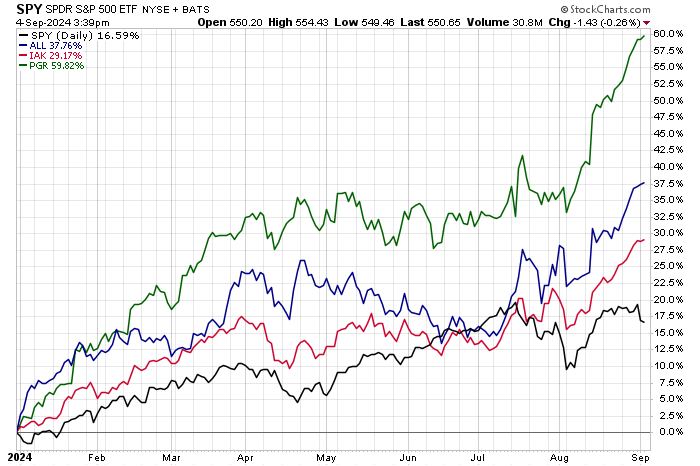-
A shift from growth to value stocks since mid-July leaves investors searching for the next high-momentum play
-
Most insurance stocks have continued to ascend, building on gains from the first half of 2024
-
As we crest the peak of hurricane season, two major insurance companies report monthly sales reports in the coming days
Berkshire Hathaway (NYSE:BRKa) became the first non-tech-related company to join the trillion-dollar market cap club late last month, just as Warren Buffett turned 94 years old. The Oracle of Omaha apparently hasn’t lost his touch, despite some criticisms that Apple (NASDAQ:AAPL) took up an outsized portion of Berkshire’s portfolio in recent years. The latest hot topic surrounding the largest company in the Financials sector is its cash pile – now almost 30% of Berkshire’s market cap and about 26% of its total assets.
Propelling the stock to all-time highs has been ongoing bullish fervor in the insurance industry. Buffett made news shortly after Berkshire’s annual shareholder meeting in May, noting that Chubb (NYSE:CB) was the mystery stock being accumulated. That turned out to be a sage move as shares of the Switzerland-based Property and Casualty firm are up more than 15% in the last four months, outpacing the S&P 500® over that span.
“Slow Money” Snatches Momentum
The insurance space has been more active over the past 12 months; just take a look at the iShares US Insurance ETF (NYSE:IAK). Each of the fund’s top 10 positions is up at least 24% since September 2023. Chubb is higher by 43% while the biggest weight, Progressive Corp (NYSE:PGR), has returned 87%, dividends included.
We noted strength among insurance equities back in the second quarter shortly after the release of the May CPI report. Unlike the Mag 7 names, these value-style stocks usually don’t capture the spotlight. What’s more, amid the tech selloff since the middle of July, IAK has kept on climbing.
Cooling Insurance Inflation, But Premiums Remain High
Boom times for insurance stocks probably isn’t too shocking to hear if you’re a homeowner and commuter (particularly if you have teenage drivers under your roof). Insurance premiums remain a notable driver of whatever inflation is left in the domestic economy, though like overall consumer prices, the rate of increase has fallen in the last handful of months. It turns out that Americans are shopping around at the highest pace on record as a result, and we’ll hear updates on the state of the insurance market later this week and next through two monthly interim reports.
Interim Data on Tap
Progressive issues its monthly sales update this Friday. Then on Monday, September 13, Allstate (NYSE:ALL) posts its August Service Level report. These sorts of monthly views are particularly important between earnings seasons – the next quarterly report of significance from the insurance industry will be from Progressive, to possibly occur on Thursday, October 10 (unconfirmed). Travelers (NYSE:TRV), Chubb, The Hartford (NYSE:HIG), Allstate, MetLife (NYSE:MET), and Prudential Financial (NYSE:PRU) all have Q3 earnings reports over the second half of next month.
Momentum can of course turn on a dime, but data from Morningstar reveal that IAK’s top 10 holdings generally trade with low price-to-earnings ratios; just PGR has a P/E above 16. Investors should not expect tech-life earnings multiples, however.10 Insurance companies tend to see steadier sales and profit trajectories, resulting in more subdued expectations and less overall cyclicality.
Insurance Stocks Chug to New Highs as the S&P 500 Stalls

Source: Stockcharts.com
‘And Let’s Toss It Over to Christine for the Weather...’
Another aspect of insurance companies is that their cost of goods sold is often not known until months or even years down the road. If premiums are on the increase, we can see that almost in real-time (or at least monthly), but if a few impactful catastrophes take place in a short period later on, then profitability can slip quickly.
Take hurricane season as an example. This week marks the peak of tropical activity, climatologically speaking. It has been a calm year for hurricanes, sans Hurricane Beryl back in June, despite forecasts that pointed to a potentially record-breaking season. All it takes is one storm to wreak havoc for insurers and hurricanes are just one type of climate-related risk to weigh.
Bigger picture, paying attention to what corporate executives and industry experts forecast regarding natural disaster trends is arguably more important than ever. Through early August, 19 weather/climate events have resulted in losses exceeding $1 billion in 2024, significantly above the inflation-adjusted average of 8.5 events, per NOAA. Hurricanes are indeed a culprit, but so too are severe storms, wildfires, winter storms, flooding, and even droughts & heat waves.
You’re Invited
We will discuss the topic of physical climate risks in detail at our upcoming Data Minds webinar. Be sure to join us on September 26 for an event on the impact of physical climate risk in business, where industry experts will discuss data-driven approaches with respect to the potential costs of asset damage, business disruption, supply chain issues, and other critical impacts in enterprise and portfolio risk management.
The Bottom Line
The reality is that momentum has shifted in markets away from growth stocks just as we hit a notoriously volatile calendar stretch. Interim data points, such as those from Progressive and Allstate, can provide important clues on the state of the global economy. It is also a busy time for conferences, so stay tuned to what key events could bring about volatility in markets.
